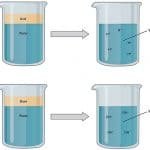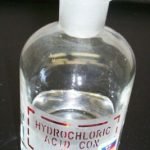The acids form an important group of chemical compounds , quite broad. What defines the acid character is that these compounds can donate one or more hydrogen (H + ) cations to another compound, which is known as the base .
Because of this property of releasing hydrogen cations it is that acids produce solutions with a pH lower than 7. Acids that can release more than one proton are called polyprotic or polyfunctional.
See also: Examples of Acids and Bases
Table of Contents
Properties
The tendency to lose protons is what determines the strength of an acid .
Strong Acids : They are compounds with a great tendency to dissociation, in which nothing (or almost nothing) of the protonated acid remains in the solution. Strong acids are usually corrosive , to the point that they can cause skin burns. In general they are very good electricity conductors .
Weak Acids : Weak acids, on the other hand, dissociate only partially, so that there is a balance between the dissociated and the non-dissociated form.
Regarding their properties, acids can be presented as liquids or as gases , more rarely as solids . The acid taste that we can all recognize and that characterizes these compounds is found, for example, in citrus fruits, which are rich in citric acid , or in vinegar, which is acetic acid . These are organic acids.
There are organic and inorganic acids; the strongest are usually the inorganic ones. Many organic acids fulfill important biological roles, within the inorganic there is one, hydrochloric acid, which plays an important role in the digestion process. Nucleic acids are also essential for life, being the basis of the genetic material of cells and containing the key to protein synthesis.
General Classification of Acids:
Acids can be classified according to different criteria set out below.
-
- Oxyacids or Oxoacids :ternary compounds with formula H a X b O c , where X is a non-metal or transition metal : H 2 SO 4 ác. sulfuric H 2 SO 3 ac. sulphurous H 2 CO 3 ac. carbonic…
- ORGANIC ACIDS :
- Monocarboxylic :organic compound with 1 carboxyl group (-COOH). CH3CH2CH2COOH…
- Dicarboxylic :organic compound with 2 carboxyl (-COOH). HOOC– (CH2) –COOH…
- Polycarboxylic :organic compound with more than 2 carboxyl groups ( -COOH ). Ex:citric acid
- Sulfonic :compound with formula R–S(=O) 2 –OH where R is a carbon chain. Ex:CH3SO2OH
- Monocarboxylic :organic compound with 1 carboxyl group (-COOH). CH3CH2CH2COOH…
- ACCORDING TO THE STRENGTH OF THE ACID :
- Strong Acids : in aqueous solution it dissociates completely(HA?H++ A–). HCl, H2SO4 …
- Weak Acids :in aqueous solution it partially dissociates (HA ? H + + A – ). CH3COOH,HCN…
- ACCORDING TO ATOMS OF H THAT DONATE :
- Monoprotic Acids : able to donate 1 proton per molecule in dissociation. HCOOH,C6H5COOH
- Diprotic Acids :able to donate 2 protons per molecule in dissociation. H2SO4…
- Polyprotic acids :able to donate more than 2 protons per molecule. H 3 PO 4 …
Acid Examples
Twenty acids are listed below, by way of example:
- Perchloric acid ( HClO4 ) – is a strong liquid acid at room temperature, highly oxidizing.
- Nitric acid ( HNO 3 ) – this is also a strong and intensely oxidizing acid, used to make certain explosives and also nitrogen fertilizers.
- Ascorbic acid ( C 6 H 8 O 6 ) – is vitamin C, so necessary for health. It is a protective substance for its antioxidant effects.
- Hydrochloric acid ( HCl ) – is the only strong acid that synthesizes the human body, specifically the stomach, to carry out the degradation of food in the digestive process.
- Tartaric acid ( C 4 H 6 O 6 ) – white crystalline powder, is used in the preparation of effervescent drinks, in the bakery, wine and pharmaceutical industry. The cream of tartar that some recipes carry is tartaric acid.
- Hydrofluoric acid ( HFl ) – for its ability to attack glass, it is used for carving and engraving crystals, among other uses.
- Sulfuric acid ( H 2 SO 4 ) – strong acid par excellence, has many applications in various industries and synthesis processes.
- Trifluoroacetic acid – is a good solvent for many organic compounds
- Phosphoric acid – present in low concentrations in several cola drinks, is considered harmful to health as it promotes decalcification.
- Acetic acid – the main component of vinegar, the acidity it creates makes it a widely used food preservative.
- Fluoroantimonic acid – is the strongest superacid known, exceeds the acidity of pure sulfuric acid by 10 19
- chromic acid – dark red powder, participates in the chrome plating process; others are used to glaze ceramics and
- Indoleacetic acid ( AIA ) – is the main representative of auxins, important plant growth hormones.
- Deoxyribonucleic acids ( DNA ) – is the one that holds the key to life, by shaping the genes that govern the synthesis of infinity of proteins.
- Phosphoric Acid H 3 PO 3 : It is usually obtained from carbonic anhydride, and they take part in several metabolic functions.
- Boric Acid H 3 BO 3 : Boric acid arises after the reaction of sodium tetraborate decahydrate, with an inorganic acid (commonly with hydrochloric acid). It is usually used as an insecticide, antiseptic and for food preservation.
- Acetylsalicylic Acid C 8 H 6 O 4 : This is one of the acids that have clinical functions, acetylsalicylic acid is aspirin, it is used to treat pain, fever and other medical uses.
- Lactic Acid C 3 H 6 O 3 : It is one of the organic acids produced by the body itself, for example after physical efforts after the processes of carbohydrate metabolization, since this acid is also found in substances such as milk (hence the name).
- Benzoic Acid C 6 H 5 -COOH: It is used for food preservation, perfumery, and other industrial uses. It usually occurs in a solid state in the form of salts, since its dissolution in water is very mild (unless it is hot, then its solubility increases).
- Tricarboxylic acid
- Formic acid
- Gluconic acid
- Malic acid
- Chronic H2CrO4
- Manganous H2MnO3



